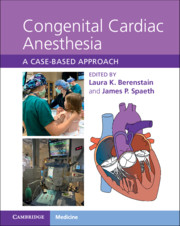Book contents
- Congenital Cardiac Anesthesia
- Congenital Cardiac Anesthesia
- Copyright page
- Dedication
- Contents
- Contributors
- Introduction
- Chapter 1 A Congenital Heart Disease Primer
- Section 1 Left-to-Right Shunts
- Section 2 Right-Sided Obstructive Lesions
- Section 3 Left-Sided Obstructive Lesions
- Section 4 Complex Mixing Lesions
- Section 5 Single-Ventricle Physiology
- Section 6 Heart Failure, Mechanical Circulatory Support, and Transplantation
- Chapter 31 Duchenne Muscular Dystrophy
- Chapter 32 Dilated Cardiomyopathy
- Chapter 33 Mixed Cardiomyopathy
- Chapter 34 Extracorporeal Membrane Oxygenation
- Chapter 35 Left Heart Ventricular Assist Device
- Chapter 36 Right Ventricular Assist Device
- Chapter 37 Lung Transplantation
- Chapter 38 Post Orthotopic Cardiac Transplantation
- Chapter 39 Failing Cardiac Transplant
- Section 7 Miscellaneous Lesions and Syndromes
- Index
- References
Chapter 37 - Lung Transplantation
from Section 6 - Heart Failure, Mechanical Circulatory Support, and Transplantation
Published online by Cambridge University Press: 09 September 2021
- Congenital Cardiac Anesthesia
- Congenital Cardiac Anesthesia
- Copyright page
- Dedication
- Contents
- Contributors
- Introduction
- Chapter 1 A Congenital Heart Disease Primer
- Section 1 Left-to-Right Shunts
- Section 2 Right-Sided Obstructive Lesions
- Section 3 Left-Sided Obstructive Lesions
- Section 4 Complex Mixing Lesions
- Section 5 Single-Ventricle Physiology
- Section 6 Heart Failure, Mechanical Circulatory Support, and Transplantation
- Chapter 31 Duchenne Muscular Dystrophy
- Chapter 32 Dilated Cardiomyopathy
- Chapter 33 Mixed Cardiomyopathy
- Chapter 34 Extracorporeal Membrane Oxygenation
- Chapter 35 Left Heart Ventricular Assist Device
- Chapter 36 Right Ventricular Assist Device
- Chapter 37 Lung Transplantation
- Chapter 38 Post Orthotopic Cardiac Transplantation
- Chapter 39 Failing Cardiac Transplant
- Section 7 Miscellaneous Lesions and Syndromes
- Index
- References
Summary
Pediatric lung transplantation is the most aggressive therapeutic option for children with end-stage pulmonary disease, but it remains a relatively rare operation. Major diagnoses necessitating transplant vary according to recipient age group. Cystic fibrosis is the most common indication in children ?6 years, while pulmonary hypertension and surfactant disorders account for the majority of cases in infants 1 year of age. Lungs are unique in that they remain directly exposed to the external environment with its infective and immunologic challenges and therefore high levels of immunosuppression are required. Acute rejection affects the majority of lung transplant recipients and typically is seen during the first 3 months post transplantation. It may be asymptomatic or present with nonspecific symptoms mimicking infection, including cough, fever, hypoxemia, tachypnea, or dyspnea. This chapter discusses the perioperative management of a patient post lung transplantation with symptomatology for diagnostic evaluation.
- Type
- Chapter
- Information
- Congenital Cardiac AnesthesiaA Case-based Approach, pp. 283 - 289Publisher: Cambridge University PressPrint publication year: 2021

